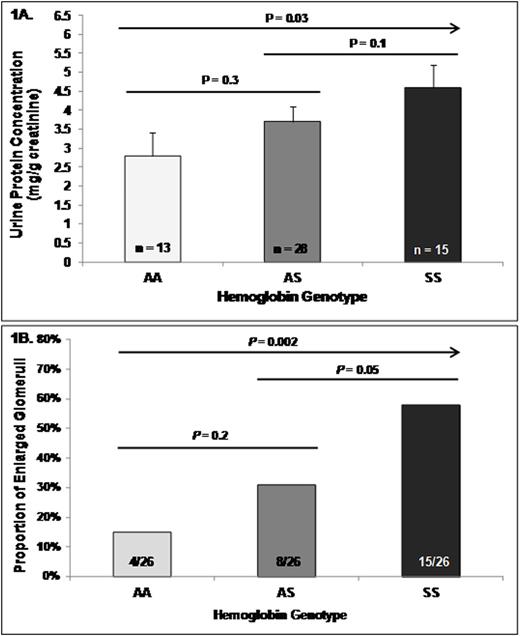Abstract

Homozygous inheritance of the hemoglobin S mutation (Hb SS; sickle cell anemia) affects 1 in 500 African Americans and is consistently associated with an increased risk for kidney disease, although the mechanisms are poorly understood. Heterozygous inheritance (Hb AS; sickle cell trait) affects 1 in 8 African Americans and has also been associated with an increased risk for kidney disease in some, but not all cohorts.
We first investigated whether inheritance of the Hb S mutation resulted in incremental kidney damage in Hb AS and Hb SS mice compared to Hb AA mice using transgenic sickle mice >6 months old (Townes model, Jackson Laboratory). Using Masson trichrome stained sections of the kidney, patterns of mesangial expansion were determined in age- and sex-matched mice by a renal pathologist blinded to the hemoglobin genotype of each specimen. Hb AS mice had diffuse (>50% of the glomeruli per slide being involved) mesangial expansion while Hb SS mice had diffuse and global (>50% of the individual glomerulus being involved) mesangial expansion. Glomerular perimeters were measured using NanoZoomer Whole Slide Imaging in 26 randomly selected glomeruli from 2 mice per genotype. Using >300µm in circumference as the definition for an enlarged glomerulus, the proportion of enlarged glomeruli progressively increased from Hb AA to Hb AS to Hb SS mice (Cochran's test of linear trend, P=0.002)(Figure 1A). Progressively higher urine protein-to-creatinine ratios were also observed from Hb AA to Hb AS to Hb SS mice (Figure 1B; test for linear trend, P=0.03) as were progressively higher kidney weights: Hb AA (429±28mg, n=8), Hb AS (446±27mg, n=18), Hb SS (567±19mg, n=5) (Test for linear trend, P=0.047).
We then compared the mRNA expression profiles in the kidney cortices, which predominantly include glomerular and proximal tubular cells, of 15 age- and sex-matched mice (5 per Hb genotype) using the Affymetrix Mouse Gene 2.0ST Array. Using an additive model with an FDR<0.01, 6 of the 10 most differentially expressed genes were involved in heme or iron metabolism (HMOX1: β 0.93, P=0.0004; SLC25A37: β 0.75, P=3.9x10-6), kidney function (SLC4A1: β 0.87, P=1.0x10-5; AQP6: β 0.79, P=2.0x10-5), or inflammation (RSAD2: β 0.76, P=5.2x10-6; C3: β 0.76, P=0.0005). Other genes that have been implicated in kidney disease and were differentially expressed at an FDR<0.01 included PODXL and EFNB2 (encode glomerular proteins integral for maintaining the filtration barrier) as well as FRMD3 and ELMO1 (implicated in diabetic nephropathy). KEGG physiologic pathways among the differentially expressed genes included focal adhesion (3.4-fold, P=6.0x10-7), extracellular matrix-receptor interaction (5.0-fold, P=3.2x10-6), and phosphatidylinositol signaling systems (3.5-fold, P=0.003).
In conclusion, we observed progressive glomerular injury, determined by mesangial expansion, proportion of enlarged glomeruli, and urine protein concentrations, in Hb AS and Hb SS mice compared to Hb AA mice. Renal cortex-expressed genes involved in heme and iron homeostasis, kidney function, and inflammation were differentially expressed with inheritance of the Hb S mutation and may play important roles in the pathophysiology of kidney disease in individuals with sickle cell trait or sickle cell disease and will require further investigation.
No relevant conflicts of interest to declare.
Author notes
Asterisk with author names denotes non-ASH members.

This icon denotes a clinically relevant abstract


This feature is available to Subscribers Only
Sign In or Create an Account Close Modal